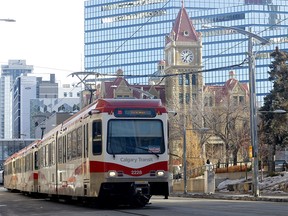‘Some people just ride the rails all day because they just have nowhere else to go’

Article content
Testimony from Calgary police officers and the city’s homeless population suggests a lack of services is pushing more people to the city’s transit systems, a new report says.
The results come from a study that sought to understand “barriers and facilitators to safety” on Calgary Transit amid a rise in disturbances and incidents on public transportation that have made transit safety a wider public issue over the past year.
Advertisement 2
Article content
Article content
“‘No place to go’ was the biggest theme we heard from everyone we interviewed,” said Lee Stevens, policy and research specialist at Vibrant Communities Calgary (VCC), which collaborated with Nick Falvo, a researcher focused on affordable housing and homelessness, and University of Calgary researchers.
The research consisted of interviews and focus groups with Calgary’s homeless population and law-enforcement authorities. A total of 16 people were interviewed via focus groups at the Calgary Drop-In Centre and the Mustard Seed shelter by 10 Calgary police officers, nine transit peace officers and two Alpha House homeless shelter staff. The two shelter staff and two peace officers are also members of Calgary Transit’s Community Outreach Team.
The report cites several reasons why drug users and people experiencing homelessness have increasingly gravitated to seek refuge on transit.
Not only are there too few places for Calgary’s homeless to go, researchers concluded, but transit stations are often the next-best option due to the lack of available space at shelters and, for some, the perceived dangers in those spaces.
Article content
Advertisement 3
Article content
Lack of resources facilitating migration to transit
Moreover, transit officers said the CTrain is perceived as a safer place to use drugs because, should they overdose, CCTV cameras and the greater public exposure increase their likelihood of survival.
That migration to transit is largely due to a lack of resources, Stevens said, including a shortage of shelter spaces, limited substance abuse and mental health treatment options, minimal harm-reduction spaces where people can use drugs, limited care at hospitals and little help for those recently discharged from hospitals.
“Some people just ride the rails all day because they just have nowhere else to go,” Stevens said.
Recommended from Editorial
The report quotes one officer saying Calgary needs to “quadruple the number of detox facilities and beds.”
Meanwhile, officers also viewed ticketing to be an ineffective tool to combat violations. “They’re displaced from the shelters and then they’re getting displaced from the train stations, but there’s nowhere for them to go. We’re just moving people around,” one CPS officer said, according to the report.
Advertisement 4
Article content
The provincial government has made its recovery-based approach to addictions a centrepiece of its term in power. Some critics have meanwhile said that focus leaves a dangerous void that could lead to unnecessary deaths.
‘Government recognizes there’s gaps’
The report included five broad policy recommendations: investing in emergency shelter, creating more treatment and harm-reduction options, increasing medical respite services, coordinating street outreach and investing in housing.
Stevens said Vibrant Communities recently met with the provincial government and said it was “a positive meeting” but did not elaborate on details.
“I think government recognizes there’s gaps and we see movement towards some of these recommendations,” she said. “I hope that this research encourages them to expand those activities.”
The findings coincide with concerning data that increasing numbers of people are dying from overdoses in public spaces. According to the latest provincial substance-use data, 42 per cent of opioid poisoning deaths in the last three months of 2023 occurred in public. Until 2023, that figure often hovered between 20 and 28 per cent of all deaths.
Advertisement 5
Article content
“That directly reflects the fact that we have a housing crisis and a lot of people living unsheltered who aren’t even able to access basic support,” Elaine Hyshka, an associate professor at U of A’s School of Public Health, said in an interview last November when deaths in public spaces hit an all-time high at 53 per cent.
Improvements made to transit safety
Recent data at least suggest Calgarians are feeling mildly safer on transit than in early 2023, a City of Calgary survey found. It found the percentage of Calgarians who feel safe riding the CTrain during the day rose five points between May 2023 and November 2023, hitting 72 per cent at the time. The city claimed this was due to recent investments in transit safety, including $15 million approved to hire 65 transit peace officers.

Still, the city said at the time that it has “a long way to go to help Calgarians feel safe in and around our trains.” In the same survey, just 39 per cent of respondents said they feel safe riding the CTrain after dark — though still a six-point improvement from May 2023.
Stevens with Vibrant Communities said transit peace officers are important frontline responders, but the responsibility of managing those situations should not fall on police officers. “We need some of these other systems to fall into place so that police officers can just be police officers,” she said.
Vibrant Communities’ report was approved by the Conjoint Health Research Ethics Board at the University of Calgary.
— Files from Scott Strasser
Article content





